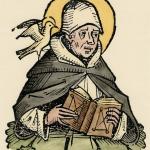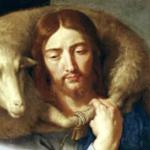 The largest stained glass church window in the world is in [choose one]: (1) Cologne, Germany; (2) The Vatican; (3) Notre Dame Cathedral, Paris, France; or (4) Covington, Kentucky.
The largest stained glass church window in the world is in [choose one]: (1) Cologne, Germany; (2) The Vatican; (3) Notre Dame Cathedral, Paris, France; or (4) Covington, Kentucky.
If you guessed “The Vatican,” you are wrong! That distinction goes to a church right here on American soil, the Cathedral Basilica of the Assumption in Covington, Kentucky.
The cathedral’s north transept window, measuring 67 feet in length by 24 feet wide, depicts the Council of Ephesus, the ecumenical council which, in the early fifth century, proclaimed Mary as the Mother of God.
This is no small potatoes! In the fifth century, some theologians—Nestorius prominent among them—began to teach that Mary was the Mother of Jesus, but not of God. Nestorius debated the unity of Christ’s natures, saying that Mary gave birth to his human nature but not his divine nature.
Pope Celestine disagreed, asserting that Jesus’ two natures—fully God and fully man—could not be divided. Supported in his teaching by St. Cyril of Alexandria, Pope Celestine convened an ecumenical council at Ephesus, Mary’s place of residence in her old age, to discuss the issue. The bishops, all 200 of them, agreed that Mary was indeed the Mother of God (called, in Greek, the Theotokos or “God-Bearer”).
According to Jewish custom, Mary and Joseph presented Jesus in the Temple on the octave of his birth (celebrated on January 1). As the new year begins, the Church honors Mary in her role as Mother of God.
* * * * *
Ten, perhaps twelve years ago, my husband and I attended a wedding in northern Kentucky. The following morning we woke in our Covington hotel room, peered out the window, and spotted the basilica’s steeple across the horizon. Hoping to find the church, we hopped in the car and set off to explore. As we arrived at the Cathedral Basilica, a busload of students from Wheaton College was unloading at the door—and we followed them into the church for what must have been a most unusual theology lesson for that group of evangelicals!
Ask a Protestant from the Reformed or Evangelical tradition what is his greatest problem with the Catholic Church, and chances are, he’ll answer “Mary.” Many, if not most, members of mainline Protestant denominations can quickly offer a laundry list of concerns about Catholic Marian dogmas: Mary’s perpetual virginity, her assumption into heaven, her immaculate conception (that is, that Mary herself, as the “ark” which held the nascent Christ Child, was preserved from all sin by God in order to be a worthy vessel for the Divine Presence). The idea of praying to Mary (who is venerated, not “worshipped,” by Catholics) is also a source of division.
But if pressed, the same Protestant is likely to admit that he has studied the Church’s teachings on Mary very little or not at all, and that he has not seriously explored the rich history of Marian devotion—back, even, to the earliest days of the Church.
It’s a little known fact that Martin Luther to his death believed the Marian dogmas which are today considered to be “Catholic,” and he approved of Marian paintings and statues in the churches of his time. Throughout his life, Luther had a deep devotion to the rosary and to Mary.














